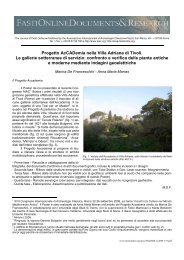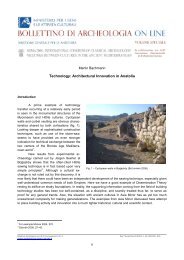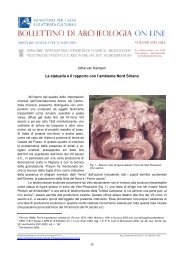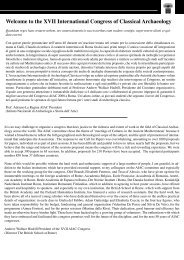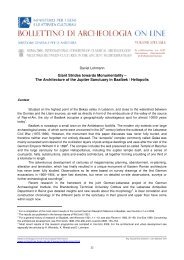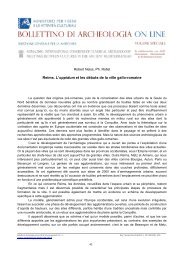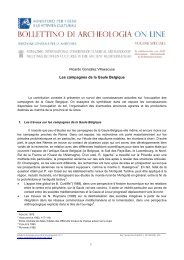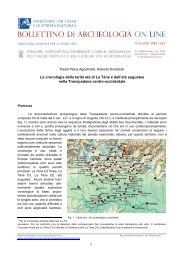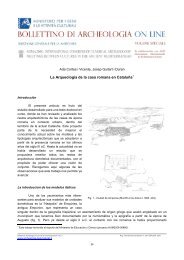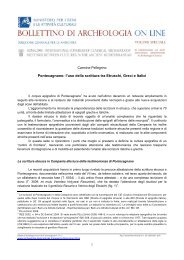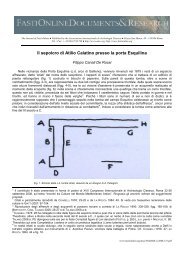Sarcophagi in Roman Britain - Bollettino di archeologia on line
Sarcophagi in Roman Britain - Bollettino di archeologia on line
Sarcophagi in Roman Britain - Bollettino di archeologia on line
Create successful ePaper yourself
Turn your PDF publications into a flip-book with our unique Google optimized e-Paper software.
Ben Russell<str<strong>on</strong>g>Sarcophagi</str<strong>on</strong>g> <str<strong>on</strong>g>in</str<strong>on</strong>g> <str<strong>on</strong>g>Roman</str<strong>on</strong>g> Brita<str<strong>on</strong>g>in</str<strong>on</strong>g>Introducti<strong>on</strong>Burial practice <str<strong>on</strong>g>in</str<strong>on</strong>g> <str<strong>on</strong>g>Roman</str<strong>on</strong>g> Brita<str<strong>on</strong>g>in</str<strong>on</strong>g> is tra<str<strong>on</strong>g>di</str<strong>on</strong>g>ti<strong>on</strong>ally <str<strong>on</strong>g>di</str<strong>on</strong>g>vided <str<strong>on</strong>g>in</str<strong>on</strong>g>to two <str<strong>on</strong>g>di</str<strong>on</strong>g>st<str<strong>on</strong>g>in</str<strong>on</strong>g>ct chr<strong>on</strong>ological phases, <strong>on</strong>echaracterised by the dom<str<strong>on</strong>g>in</str<strong>on</strong>g>ance of cremati<strong>on</strong>, the other <str<strong>on</strong>g>in</str<strong>on</strong>g>humati<strong>on</strong>, as the preferred burial rite 1 . The first ofthese is generally identified as runn<str<strong>on</strong>g>in</str<strong>on</strong>g>g from the period of the <str<strong>on</strong>g>Roman</str<strong>on</strong>g> c<strong>on</strong>quest (AD 43) to the late 2 nd centuryAD, the sec<strong>on</strong>d from this po<str<strong>on</strong>g>in</str<strong>on</strong>g>t <strong>on</strong>wards. Both are c<strong>on</strong>nected with developments bey<strong>on</strong>d the c<strong>on</strong>f<str<strong>on</strong>g>in</str<strong>on</strong>g>es of theprov<str<strong>on</strong>g>in</str<strong>on</strong>g>ce, and particularly at Rome where the gradual shift from cremati<strong>on</strong> to <str<strong>on</strong>g>in</str<strong>on</strong>g>humati<strong>on</strong> had its roots <str<strong>on</strong>g>in</str<strong>on</strong>g> thelate 1 st or early 2 nd century AD. Of course, neither of these phases brought sweep<str<strong>on</strong>g>in</str<strong>on</strong>g>g changes to thecemeteries of Brita<str<strong>on</strong>g>in</str<strong>on</strong>g>. The burial practices of pre-<str<strong>on</strong>g>Roman</str<strong>on</strong>g> Ir<strong>on</strong> Age Brita<str<strong>on</strong>g>in</str<strong>on</strong>g> were extremely localized, both <str<strong>on</strong>g>in</str<strong>on</strong>g>geographic and chr<strong>on</strong>ological terms. Cremati<strong>on</strong>, the pr<str<strong>on</strong>g>in</str<strong>on</strong>g>cipal burial rite at Rome and <str<strong>on</strong>g>in</str<strong>on</strong>g> the westernprov<str<strong>on</strong>g>in</str<strong>on</strong>g>ces at the time of the c<strong>on</strong>quest, was already the dom<str<strong>on</strong>g>in</str<strong>on</strong>g>ant rite <str<strong>on</strong>g>in</str<strong>on</strong>g> south-east Brita<str<strong>on</strong>g>in</str<strong>on</strong>g>, and had beens<str<strong>on</strong>g>in</str<strong>on</strong>g>ce the mid 1 st century BC 2 . Elsewhere, where <str<strong>on</strong>g>in</str<strong>on</strong>g>humati<strong>on</strong> was the norm, a shift towards cremati<strong>on</strong> isnoticeable but not ubiquitous 3 . Military and urban sites, where the number of n<strong>on</strong>-native Brit<strong>on</strong>s was probablyhigher, offer the greatest density of cremati<strong>on</strong>s <str<strong>on</strong>g>in</str<strong>on</strong>g> the 1 st century AD 4 . At many sites the <str<strong>on</strong>g>di</str<strong>on</strong>g>fferent ritesc<strong>on</strong>t<str<strong>on</strong>g>in</str<strong>on</strong>g>ued side-by-side: at the cemetery at Jordan Hill, <str<strong>on</strong>g>in</str<strong>on</strong>g> Dorset, for example, <str<strong>on</strong>g>in</str<strong>on</strong>g>humati<strong>on</strong>s c<strong>on</strong>t<str<strong>on</strong>g>in</str<strong>on</strong>g>uedal<strong>on</strong>gside cremati<strong>on</strong>s well <str<strong>on</strong>g>in</str<strong>on</strong>g>to the 2 nd century AD 5 . At the same time and <str<strong>on</strong>g>in</str<strong>on</strong>g> parallel with these developmentspre-<str<strong>on</strong>g>Roman</str<strong>on</strong>g> <str<strong>on</strong>g>in</str<strong>on</strong>g>humati<strong>on</strong> practices c<strong>on</strong>t<str<strong>on</strong>g>in</str<strong>on</strong>g>ued unaffected <str<strong>on</strong>g>in</str<strong>on</strong>g> many more remote, less-urbanized areas.In large areas of the prov<str<strong>on</strong>g>in</str<strong>on</strong>g>ce, therefore, the sec<strong>on</strong>d major shift – this time from cremati<strong>on</strong> to<str<strong>on</strong>g>in</str<strong>on</strong>g>humati<strong>on</strong> – <str<strong>on</strong>g>in</str<strong>on</strong>g> the late 2 nd century AD represented a return to tra<str<strong>on</strong>g>di</str<strong>on</strong>g>ti<strong>on</strong>al practices; elsewhere it was asimple c<strong>on</strong>t<str<strong>on</strong>g>in</str<strong>on</strong>g>uati<strong>on</strong>. Nevertheless, <str<strong>on</strong>g>in</str<strong>on</strong>g> regi<strong>on</strong>s where <str<strong>on</strong>g>Roman</str<strong>on</strong>g> <str<strong>on</strong>g>in</str<strong>on</strong>g>fluence was greatest, where cremati<strong>on</strong> ritesachieved dom<str<strong>on</strong>g>in</str<strong>on</strong>g>ance post-c<strong>on</strong>quest, the return of <str<strong>on</strong>g>in</str<strong>on</strong>g>humati<strong>on</strong> represented a more fundamental change <str<strong>on</strong>g>in</str<strong>on</strong>g>practice, <strong>on</strong>e mirror<str<strong>on</strong>g>in</str<strong>on</strong>g>g developments that had begun at Rome <str<strong>on</strong>g>in</str<strong>on</strong>g> the late 1 st and early 2 nd centuries AD 6 .Though traces of wooden burial c<strong>on</strong>ta<str<strong>on</strong>g>in</str<strong>on</strong>g>ers have been identified <str<strong>on</strong>g>in</str<strong>on</strong>g> early <str<strong>on</strong>g>Roman</str<strong>on</strong>g>, possibly even pre-<str<strong>on</strong>g>Roman</str<strong>on</strong>g>, c<strong>on</strong>texts, it would appear that the use of coff<str<strong>on</strong>g>in</str<strong>on</strong>g>s <strong>on</strong>ly became comm<strong>on</strong> <str<strong>on</strong>g>in</str<strong>on</strong>g> Brita<str<strong>on</strong>g>in</str<strong>on</strong>g> <str<strong>on</strong>g>in</str<strong>on</strong>g> this later period –that is, the late 2 nd and early 3 rd centuries AD 7 . Inhumati<strong>on</strong> was generally a cheaper form of burial rite than1 See the recent syntheses by Philpott (1991) and Taylor (2001).2 See WHIMSTER 1981 <strong>on</strong> the general subject of burial <str<strong>on</strong>g>in</str<strong>on</strong>g> pre-<str<strong>on</strong>g>Roman</str<strong>on</strong>g> Ir<strong>on</strong> Age Brita<str<strong>on</strong>g>in</str<strong>on</strong>g>; <strong>on</strong> the South-East, <str<strong>on</strong>g>in</str<strong>on</strong>g> particular, WHIMSTER 1981,147–166, and PHILPOTT 1991, 6–7.3 WAIT 1986, 83–121, and TAYLOR 2001, 87–90.4 PHILPOTT 1991, 8.5 WATTS 1991, 114.6 See NOCK 1932, 325, and TOYNBEE 1971, 40.7 See WHIMSTER 1981, 271, for the skelet<strong>on</strong> of a child <str<strong>on</strong>g>in</str<strong>on</strong>g> a wooden coff<str<strong>on</strong>g>in</str<strong>on</strong>g> from a cist burial at Worth Matravers <str<strong>on</strong>g>in</str<strong>on</strong>g> Dorset.Bollett<str<strong>on</strong>g>in</str<strong>on</strong>g>o <str<strong>on</strong>g>di</str<strong>on</strong>g> Archeologia <strong>on</strong> l<str<strong>on</strong>g>in</str<strong>on</strong>g>e I 2010/ Volume speciale E / E10 / 2 Reg. Tribunale Roma 05.08.2010 n. 330 ISSN 2039 - 0076www.<str<strong>on</strong>g>archeologia</str<strong>on</strong>g>.beniculturali.it/pages/pubblicazi<strong>on</strong>i.html14
XVII Internati<strong>on</strong>al C<strong>on</strong>gress of Classical Archaeology, Roma 22-26 Sept. 2008Sessi<strong>on</strong>: <str<strong>on</strong>g>Roman</str<strong>on</strong>g> and Barbariancremati<strong>on</strong> so the use of any coff<str<strong>on</strong>g>in</str<strong>on</strong>g> at all can be seen as a dem<strong>on</strong>strati<strong>on</strong> of some level of wealth or perceivedstatus 8 .MaterialsThree materials are used for coff<str<strong>on</strong>g>in</str<strong>on</strong>g>s <str<strong>on</strong>g>in</str<strong>on</strong>g> Brita<str<strong>on</strong>g>in</str<strong>on</strong>g>: wood, lead and st<strong>on</strong>e. Unsurpris<str<strong>on</strong>g>in</str<strong>on</strong>g>gly, lead and st<strong>on</strong>eappear to have been the more prestigious but this is not to say that wooden coff<str<strong>on</strong>g>in</str<strong>on</strong>g>s were somehow lowstatus. Of the 453 burials excavated at the Bath Gate cemetery at Cirencester, for example, <strong>on</strong>ly 72 (16%)were c<strong>on</strong>ta<str<strong>on</strong>g>in</str<strong>on</strong>g>ed with<str<strong>on</strong>g>in</str<strong>on</strong>g> wooden coff<str<strong>on</strong>g>in</str<strong>on</strong>g>s; at the same time <strong>on</strong>ly <strong>on</strong>e (0.2%) was c<strong>on</strong>ta<str<strong>on</strong>g>in</str<strong>on</strong>g>ed <str<strong>on</strong>g>in</str<strong>on</strong>g> a lead coff<str<strong>on</strong>g>in</str<strong>on</strong>g>, and<strong>on</strong>ly five (1.1%) <str<strong>on</strong>g>in</str<strong>on</strong>g> st<strong>on</strong>e coff<str<strong>on</strong>g>in</str<strong>on</strong>g>s. At the somewhat wealthier Cemetery 3 at Poundbury, c<strong>on</strong>ta<str<strong>on</strong>g>in</str<strong>on</strong>g><str<strong>on</strong>g>in</str<strong>on</strong>g>g burialsdat<str<strong>on</strong>g>in</str<strong>on</strong>g>g ma<str<strong>on</strong>g>in</str<strong>on</strong>g>ly to the 4 th century AD, 856 (77%) of the 1118 burials excavated prior to 1982 were <str<strong>on</strong>g>in</str<strong>on</strong>g> woodencoff<str<strong>on</strong>g>in</str<strong>on</strong>g>s, <strong>on</strong>ly 75 (7%) <str<strong>on</strong>g>in</str<strong>on</strong>g> lead or st<strong>on</strong>e <strong>on</strong>es 9 . At the Trentholme Drive site <str<strong>on</strong>g>in</str<strong>on</strong>g> York, <strong>on</strong> the other hand, almostall of the 350 burials excavated were c<strong>on</strong>ta<str<strong>on</strong>g>in</str<strong>on</strong>g>ed with<str<strong>on</strong>g>in</str<strong>on</strong>g> coff<str<strong>on</strong>g>in</str<strong>on</strong>g>s but <strong>on</strong>ly two of them were st<strong>on</strong>e 10 .In all of these cases the choice of material appears to have held particular significance. As Toller hasnoted <str<strong>on</strong>g>in</str<strong>on</strong>g> his catalogue of the lead coff<str<strong>on</strong>g>in</str<strong>on</strong>g>s of <str<strong>on</strong>g>Roman</str<strong>on</strong>g> Brita<str<strong>on</strong>g>in</str<strong>on</strong>g> the <str<strong>on</strong>g>di</str<strong>on</strong>g>stributi<strong>on</strong> of these 243 pieces is reflectiveless of the locati<strong>on</strong> of lead resources than it is of the ‘wealth <str<strong>on</strong>g>in</str<strong>on</strong>g> <str<strong>on</strong>g>Roman</str<strong>on</strong>g> Brita<str<strong>on</strong>g>in</str<strong>on</strong>g>’ more generally 11 . In otherwords, people were not simply us<str<strong>on</strong>g>in</str<strong>on</strong>g>g the material that was to hand. The majority of the lead pieces arespread over south-eastern and southern Brita<str<strong>on</strong>g>in</str<strong>on</strong>g>, with 55% com<str<strong>on</strong>g>in</str<strong>on</strong>g>g from cemeteries <str<strong>on</strong>g>di</str<strong>on</strong>g>rectly associated withmajor urban centres, particularly York, Dorchester, Colchester and L<strong>on</strong>d<strong>on</strong> 12 . Even <str<strong>on</strong>g>in</str<strong>on</strong>g> a prov<str<strong>on</strong>g>in</str<strong>on</strong>g>ce wellendowedwith m<str<strong>on</strong>g>in</str<strong>on</strong>g>eral resources, lead can never have been a cheap material <str<strong>on</strong>g>in</str<strong>on</strong>g> which to bury <strong>on</strong>eself. Thesame is no doubt true of st<strong>on</strong>e.The decorated sarcophagi<str<strong>on</strong>g>Roman</str<strong>on</strong>g>o-British sarcophagi, or st<strong>on</strong>e coff<str<strong>on</strong>g>in</str<strong>on</strong>g>s, are relatively comm<strong>on</strong> but, due to the scarcity ofdecorated pieces, have received little scholarly attenti<strong>on</strong> 13 . The same is true of the numerous undecoratedsarcophagi from Gaul and the Rh<str<strong>on</strong>g>in</str<strong>on</strong>g>eland. In part this is because these pla<str<strong>on</strong>g>in</str<strong>on</strong>g>-sided pieces do not fit theresearch agenda of the more art historically m<str<strong>on</strong>g>in</str<strong>on</strong>g>ded scholars who have been resp<strong>on</strong>sible for the publicati<strong>on</strong>of the bulk of sculpted st<strong>on</strong>e objects <str<strong>on</strong>g>in</str<strong>on</strong>g> the north-western prov<str<strong>on</strong>g>in</str<strong>on</strong>g>ces (fig. 1). In her comprehensive study of art<str<strong>on</strong>g>in</str<strong>on</strong>g> Brita<str<strong>on</strong>g>in</str<strong>on</strong>g> under the <str<strong>on</strong>g>Roman</str<strong>on</strong>g>s, for example, Toynbee menti<strong>on</strong>s seven sarcophagi, of which <strong>on</strong>ly five arecarved from local materials 14 . However, sarcophagi have also received little attenti<strong>on</strong> <str<strong>on</strong>g>in</str<strong>on</strong>g> stu<str<strong>on</strong>g>di</str<strong>on</strong>g>es of <str<strong>on</strong>g>Roman</str<strong>on</strong>g>o-British funerary practice; <str<strong>on</strong>g>in</str<strong>on</strong>g> her study of high-status burials between the 1 st and 3 rd centuries, for example,Struck <str<strong>on</strong>g>di</str<strong>on</strong>g>scusses built funerary m<strong>on</strong>uments, grave goods, and the locati<strong>on</strong> of burials, but not sarcophagi 15 .In fact, well over a hundred <str<strong>on</strong>g>Roman</str<strong>on</strong>g>o-British sarcophagi have been identified. These fall <str<strong>on</strong>g>in</str<strong>on</strong>g>to three<str<strong>on</strong>g>di</str<strong>on</strong>g>st<str<strong>on</strong>g>in</str<strong>on</strong>g>ct categories:1. Imports (carved from n<strong>on</strong>-British st<strong>on</strong>e, probably outside of the prov<str<strong>on</strong>g>in</str<strong>on</strong>g>ce).2. Locally-produced decorated or <str<strong>on</strong>g>in</str<strong>on</strong>g>scribed pieces (<str<strong>on</strong>g>in</str<strong>on</strong>g> British st<strong>on</strong>e).3. Locally-produced undecorated pieces (<str<strong>on</strong>g>in</str<strong>on</strong>g> British st<strong>on</strong>e) 16 .…………………………………………8 See PHILPOTT 1991, 53, and QUENSEL-VON-KALBEN 2000, 223.9 See GREEN 1982, 64.10 See VINER, LEECH 1982, 69–88, and WENHAM 1968, 33–39.11 TOLLER 1977.12 TOLLER 1977, 2–3.13 On this po<str<strong>on</strong>g>in</str<strong>on</strong>g>t, see PHILPOTT 1991, 53.14 See TOYNBEE 1964, 210–211; as Walker (1990, 9) has noted, un-decorated sarcophagi are <strong>on</strong>ly fleet<str<strong>on</strong>g>in</str<strong>on</strong>g>gly <str<strong>on</strong>g>di</str<strong>on</strong>g>scussed <str<strong>on</strong>g>in</str<strong>on</strong>g> KOCH,SICHTERMANN 1982, and were not catalogued by Espéran<str<strong>on</strong>g>di</str<strong>on</strong>g>eu.15 STRUCK 2000, 85–92.16 There appear to be no examples of a possible fourth category, locally-produced sarcophagi carved from imported materials, like thenorth-Italian sarcophagi <str<strong>on</strong>g>di</str<strong>on</strong>g>scussed <str<strong>on</strong>g>in</str<strong>on</strong>g> GABELMANN 1973, many of which are carved <str<strong>on</strong>g>in</str<strong>on</strong>g> Proc<strong>on</strong>nesian marble.Bollett<str<strong>on</strong>g>in</str<strong>on</strong>g>o <str<strong>on</strong>g>di</str<strong>on</strong>g> Archeologia <strong>on</strong> l<str<strong>on</strong>g>in</str<strong>on</strong>g>e I 2010/ Volume speciale E / E10 / 2 Reg. Tribunale Roma 05.08.2010 n. 330 ISSN 2039 - 0076www.<str<strong>on</strong>g>archeologia</str<strong>on</strong>g>.beniculturali.it/pages/pubblicazi<strong>on</strong>i.html15
B. Russell – <str<strong>on</strong>g>Sarcophagi</str<strong>on</strong>g> <str<strong>on</strong>g>in</str<strong>on</strong>g> <str<strong>on</strong>g>Roman</str<strong>on</strong>g> Brita<str<strong>on</strong>g>in</str<strong>on</strong>g>Abb. 1 – Undecorated <str<strong>on</strong>g>Roman</str<strong>on</strong>g>o-British sarcophagi <str<strong>on</strong>g>in</str<strong>on</strong>g> the gardens of the Yorkshire Museum.Only three sarcophagi from Brita<str<strong>on</strong>g>in</str<strong>on</strong>g> can be assigned c<strong>on</strong>fidently to the first of these categories. Twoare products of metropolitan workshops while a fragmentary third example, carved from Pentelic marble,must be Attic <str<strong>on</strong>g>in</str<strong>on</strong>g> form 17 . All come from rural sites close to L<strong>on</strong>d<strong>on</strong> and apparently date to the first half of the3 rd century AD. A fourth piece, the marble fragment depict<str<strong>on</strong>g>in</str<strong>on</strong>g>g the Muses found built <str<strong>on</strong>g>in</str<strong>on</strong>g>to the wall of a church<str<strong>on</strong>g>in</str<strong>on</strong>g> Harwich and now <str<strong>on</strong>g>in</str<strong>on</strong>g> the British Museum, is less certa<str<strong>on</strong>g>in</str<strong>on</strong>g>ly an ancient import 18 . The st<strong>on</strong>e used <str<strong>on</strong>g>in</str<strong>on</strong>g> not ofMe<str<strong>on</strong>g>di</str<strong>on</strong>g>terranean orig<str<strong>on</strong>g>in</str<strong>on</strong>g> but could be Pyrenean. S<str<strong>on</strong>g>in</str<strong>on</strong>g>ce Koch and Sichtermann argued that it was a prov<str<strong>on</strong>g>in</str<strong>on</strong>g>cialcopy of a metropolitan type, it might represent an import from Gaul 19 . However, this is pure hypothesis and,as Walker notes, it could just as likely be a later collector’s piece, perhaps reworked <str<strong>on</strong>g>in</str<strong>on</strong>g> the 18 th or 19 thcenturies, and so not an ancient import. S<str<strong>on</strong>g>in</str<strong>on</strong>g>ce all of the imported architectural elements <str<strong>on</strong>g>in</str<strong>on</strong>g> Brita<str<strong>on</strong>g>in</str<strong>on</strong>g> are oflimited <str<strong>on</strong>g>di</str<strong>on</strong>g>mensi<strong>on</strong>s, these sarcophagi are the largest s<str<strong>on</strong>g>in</str<strong>on</strong>g>gle imported st<strong>on</strong>e objects <str<strong>on</strong>g>in</str<strong>on</strong>g> Brita<str<strong>on</strong>g>in</str<strong>on</strong>g> 20 . Though n<strong>on</strong>e17 The two metropolitan pieces, from Clapt<strong>on</strong> (L<strong>on</strong>d<strong>on</strong>) and Englefield Green (Surrey), are <str<strong>on</strong>g>di</str<strong>on</strong>g>scussed by Toynbee (1964, 210–211),while the Attic piece from Welwyn (Hertfordshire) is described <str<strong>on</strong>g>in</str<strong>on</strong>g> Rook, Walker and DENSTON 1984, 149–160; more fragments of theWelwyn sarcophagus are due to be published by M. Henig <str<strong>on</strong>g>in</str<strong>on</strong>g> a forthcom<str<strong>on</strong>g>in</str<strong>on</strong>g>g CSIR volume.18 WALKER 1990, no. 70.19 KOCH, SICHTERMANN 1982, 308.20 Most marble was imported <str<strong>on</strong>g>in</str<strong>on</strong>g>to Brita<str<strong>on</strong>g>in</str<strong>on</strong>g> <str<strong>on</strong>g>in</str<strong>on</strong>g> panel form, for use as wall veneer or floor tiles; statues are found but they are generallysmall <str<strong>on</strong>g>in</str<strong>on</strong>g> size (excepti<strong>on</strong>s be<str<strong>on</strong>g>in</str<strong>on</strong>g>g the busts from the villa at Lull<str<strong>on</strong>g>in</str<strong>on</strong>g>gst<strong>on</strong>e <str<strong>on</strong>g>in</str<strong>on</strong>g> Kent now <str<strong>on</strong>g>in</str<strong>on</strong>g> the British Museum (see TOYNBEE 1964, 59–62);the largest imported architectural elements meanwhile are the small columns and capitals <str<strong>on</strong>g>in</str<strong>on</strong>g> French limest<strong>on</strong>e from the Ner<strong>on</strong>ian andFlavian phases of the palatial-villa at Fishbourne (see BLAGG 1990, 35).Bollett<str<strong>on</strong>g>in</str<strong>on</strong>g>o <str<strong>on</strong>g>di</str<strong>on</strong>g> Archeologia <strong>on</strong> l<str<strong>on</strong>g>in</str<strong>on</strong>g>e I 2010/ Volume speciale E / E10 / 2 Reg. Tribunale Roma 05.08.2010 n. 330 ISSN 2039 - 0076www.<str<strong>on</strong>g>archeologia</str<strong>on</strong>g>.beniculturali.it/pages/pubblicazi<strong>on</strong>i.html16
XVII Internati<strong>on</strong>al C<strong>on</strong>gress of Classical Archaeology, Roma 22-26 Sept. 2008Sessi<strong>on</strong>: <str<strong>on</strong>g>Roman</str<strong>on</strong>g> and Barbarianare <str<strong>on</strong>g>in</str<strong>on</strong>g>scribed, their owners were obviously wealthy <str<strong>on</strong>g>in</str<strong>on</strong>g><str<strong>on</strong>g>di</str<strong>on</strong>g>viduals: the fragmentary Attic piece, at least, wasrecovered from a large and prom<str<strong>on</strong>g>in</str<strong>on</strong>g>ent mausoleum at Welwyn 21 .Table 1 – The <str<strong>on</strong>g>in</str<strong>on</strong>g>scribed sarcophagi of <str<strong>on</strong>g>Roman</str<strong>on</strong>g> Brita<str<strong>on</strong>g>in</str<strong>on</strong>g>.F<str<strong>on</strong>g>in</str<strong>on</strong>g>dsp ot S it e I nscripti<strong>on</strong>1 York Driffield Est ate, The M ount D(is) M(an ibus) | Ae l(iae ) Sever(a)e h<strong>on</strong>est(a)e f em <str<strong>on</strong>g>in</str<strong>on</strong>g>(a)e |c<strong>on</strong>iu gi Caec(ili) Rufi quo nd(am) | v(ixit) an(nos) X XVII m (e nse s)V III d(ies) I III Ca ec(iliu s) | Musicus lib(ert us) e[ i]us p(osu it )2 York Castle Y ard D(is) M(an ibus) | Au r(elio) S upero cent(uri<strong>on</strong>i) | leg (i<strong>on</strong>is) VI qu ivixit a n(n)is | X XXVI II m (ensibu s) IIII d(ieb us) XI II A ure|liaCenso r<str<strong>on</strong>g>in</str<strong>on</strong>g>a co niux | m em oriam p osuit3 York S carboroug h Ra ilway Brid ge D(is) M(an ibus) | Fl[a] vi Bellatoris d ec(uri<strong>on</strong> is) col(<strong>on</strong>iae)E boracen s(is) | vixit annis XX VIII m esib [us … | …] II I[…] II […]4 York S carboroug h Ra ilway Brid ge I ul(iae) Fortuna t(a)e dom o | S ard<str<strong>on</strong>g>in</str<strong>on</strong>g>ia Ve re c(un<str<strong>on</strong>g>di</str<strong>on</strong>g>o) Dio|geni f idac<strong>on</strong>iu ncta | m arito5 York Castle Y ard D(is) M(an ibus) | et m emoriae Iuliae V ict or<str<strong>on</strong>g>in</str<strong>on</strong>g>(a)e | qu ae vixitann os XXVI III me nse s I I d ie s XV | e t C<strong>on</strong>stantio qui vixit annosI V <str<strong>on</strong>g>di</str<strong>on</strong>g>es X XI | menses XI Se ptim ius Lupian us (=cen tu rio) e xevoc(at o) | co niugi e t filio m emoriam posu it6 York Driffield Est ate, The M ount D(is) M(an ibus) S imp lic ia e Flo re nt<str<strong>on</strong>g>in</str<strong>on</strong>g> (a )e | a nim e <str<strong>on</strong>g>in</str<strong>on</strong>g>no cen tissim e |que vixit m en ses dec em | Felicius Sim p lex pa ter f ecit | leg VI V7 York Driffield Est ate, The M ount M em (oriae) [V] al(erii) Theod ori|an i [N]om ent(ani) vixit ann (os) |X XXV m(en ses ) V I E m i The o|do [r]a m ater e(ius) c(ausa)8 York S carboroug h Ra ilway Brid ge M (arcus) V erec(un<str<strong>on</strong>g>di</str<strong>on</strong>g>us ) Diogenes sevir col(<strong>on</strong> ia e) |E bor(acensis) ide m q[ u<str<strong>on</strong>g>in</str<strong>on</strong>g>q (uennalis) e t] cive s B it urix | Cubushae c sibi vivu s fe cit9 Yorkshire S ut t<strong>on</strong> -u nder-W h itest <strong>on</strong>eCliffD(is) M(an ibus) | Co sc(<strong>on</strong>iae) M am m iolae co ni(ugi) piisim (ae) |A ur(elius) Serenu s10 L <strong>on</strong>d<strong>on</strong> W e stm <str<strong>on</strong>g>in</str<strong>on</strong>g>st er Abbey M em oriae V aler(i) A m an|d<str<strong>on</strong>g>in</str<strong>on</strong>g>i V aleri S upe rve n|tor et M arcelluspat ri f ece r(un t)More can be said about the decorated local products. These are represented by fifteen examples –two from L<strong>on</strong>d<strong>on</strong>, thirteen from York – ten of which are <str<strong>on</strong>g>in</str<strong>on</strong>g>scribed. 22 The data recoverable from their<str<strong>on</strong>g>in</str<strong>on</strong>g>scripti<strong>on</strong>s are detailed <str<strong>on</strong>g>in</str<strong>on</strong>g> Table 1. Seven of these sarcophagi can be assigned tentatively to eithercenturi<strong>on</strong>s, civil magistrates or members of their families. Aurelius Superus and Felicius Simplex (no. 2 and6) both give their legi<strong>on</strong> as VI Victrix, stati<strong>on</strong>ed <str<strong>on</strong>g>in</str<strong>on</strong>g> Brita<str<strong>on</strong>g>in</str<strong>on</strong>g> s<str<strong>on</strong>g>in</str<strong>on</strong>g>ce at least AD 122. Septimius Lupianus (no. 5), acenturi<strong>on</strong> ex evocatis, must have previously served <str<strong>on</strong>g>in</str<strong>on</strong>g> the Praetorian Guard 23 . Flavius Bellator (no. 3) recordsthat he was a decuri<strong>on</strong> of the col<strong>on</strong>ia of Eburacum, while Aelia Severa (no. 1) might be the daughter or wifeof another member of the ordo decuri<strong>on</strong>um, given her title of h<strong>on</strong>esta fem<str<strong>on</strong>g>in</str<strong>on</strong>g>a 24 . Marcus Verecun<str<strong>on</strong>g>di</str<strong>on</strong>g>usDiogenes (no. 8), furthermore, <strong>on</strong> a now lost sarcophagus, identifies himself as a sevir col<strong>on</strong>iae Eboracensisand it is likely that Julia Fortunata (no. 4) is his wife. Of the York pieces, therefore, <strong>on</strong>ly Aurelius Serenus andValerius Theodorianus give no <str<strong>on</strong>g>in</str<strong>on</strong>g><str<strong>on</strong>g>di</str<strong>on</strong>g>cati<strong>on</strong> of their status.The names of these <str<strong>on</strong>g>in</str<strong>on</strong>g><str<strong>on</strong>g>di</str<strong>on</strong>g>viduals are also reflective of their class: many are unparalleled <str<strong>on</strong>g>in</str<strong>on</strong>g> Brita<str<strong>on</strong>g>in</str<strong>on</strong>g>, likethe cognom<str<strong>on</strong>g>in</str<strong>on</strong>g>a Bellator and Superus, while others are generally rare, like Lupianus and Censor<str<strong>on</strong>g>in</str<strong>on</strong>g>a. Foreignl<str<strong>on</strong>g>in</str<strong>on</strong>g>ks are specifically noted <str<strong>on</strong>g>in</str<strong>on</strong>g> the case of Marcus Verecun<str<strong>on</strong>g>di</str<strong>on</strong>g>us Diogenes, a citizen of the Bituriges Cubi from21 ROOK, WALKER, DENSTON 1984, 159.22 L<strong>on</strong>d<strong>on</strong>: RCHM England 1928, Plate 57. York: four from the Driffield Estate, The Mount (RAMM 1958, 412–413 (TUFI 1983, no. 77)and 414–415 (no. 1 (TUFI 1983, no. 64), 6 and 7)), three from the area of the Railway Stati<strong>on</strong> (TUFI 1983, no. 67–69) and three from thenearby Scarborough Railway Bridge (RAMM 1958, 414–415 (no. 3 (TUFI 1983, no. 62), 4 (TUFI 1983, no. 60) and 8 (TUFI 1983, no. 65))),as well as two from Castle Yard (RAMM 1958, 402–403 and 414 (no. 2 (=TUFI 1983, no. 63)) and 402–403 and 414 (no. 5 (=TUFI 1983,no. 61)); <str<strong>on</strong>g>in</str<strong>on</strong>g> ad<str<strong>on</strong>g>di</str<strong>on</strong>g>ti<strong>on</strong>, a s<str<strong>on</strong>g>in</str<strong>on</strong>g>gle <str<strong>on</strong>g>in</str<strong>on</strong>g>scribed sarcophagus was found <str<strong>on</strong>g>in</str<strong>on</strong>g> 1956 at Sutt<strong>on</strong>-under-Whitest<strong>on</strong>e Cliff, near Thirsk (WENHAM 1960,298–300).23 RAMM 1958, 402–403.24 See TUFI 1983, no. 64 (42–43 <strong>on</strong> this po<str<strong>on</strong>g>in</str<strong>on</strong>g>t).Bollett<str<strong>on</strong>g>in</str<strong>on</strong>g>o <str<strong>on</strong>g>di</str<strong>on</strong>g> Archeologia <strong>on</strong> l<str<strong>on</strong>g>in</str<strong>on</strong>g>e I 2010/ Volume speciale E / E10 / 2 Reg. Tribunale Roma 05.08.2010 n. 330 ISSN 2039 - 0076www.<str<strong>on</strong>g>archeologia</str<strong>on</strong>g>.beniculturali.it/pages/pubblicazi<strong>on</strong>i.html17
B. Russell – <str<strong>on</strong>g>Sarcophagi</str<strong>on</strong>g> <str<strong>on</strong>g>in</str<strong>on</strong>g> <str<strong>on</strong>g>Roman</str<strong>on</strong>g> Brita<str<strong>on</strong>g>in</str<strong>on</strong>g>Aquitania 25 . The <str<strong>on</strong>g>in</str<strong>on</strong>g>scribed sarcophagi of York <str<strong>on</strong>g>in</str<strong>on</strong>g> particular, therefore, give a remarkable snap-shot of theupper classes of the city. Most probably date to the 3 rd century AD; those menti<strong>on</strong><str<strong>on</strong>g>in</str<strong>on</strong>g>g the col<strong>on</strong>ia ofEburacum post-date 208–211 when the city was granted this status. Indeed it is surely no accident thatthese pieces date to the period imme<str<strong>on</strong>g>di</str<strong>on</strong>g>ately follow<str<strong>on</strong>g>in</str<strong>on</strong>g>g the establishment of the col<strong>on</strong>y.The decorative schemes of these pieces also dem<strong>on</strong>strate an awareness of artistic trends outside ofBrita<str<strong>on</strong>g>in</str<strong>on</strong>g>. The sarcophagi of Julia Fortunata and Verecun<str<strong>on</strong>g>di</str<strong>on</strong>g>us Diogenes both have tabulae ansatae with peltashapedansae <strong>on</strong> their fr<strong>on</strong>t facades, similar to three identical un<str<strong>on</strong>g>in</str<strong>on</strong>g>scribed pieces also from York 26 . Rougherversi<strong>on</strong>s of these pelta-shaped ansae are found <strong>on</strong> the sarcophagi of Aurelius Superus and Aelia Severa 27 .The sarcophagus of Flavius Bellator meanwhile has a more tra<str<strong>on</strong>g>di</str<strong>on</strong>g>ti<strong>on</strong>ally shaped tabula ansata. Ansaeshaped as peltae are not uncomm<strong>on</strong> <str<strong>on</strong>g>in</str<strong>on</strong>g> Brita<str<strong>on</strong>g>in</str<strong>on</strong>g> but close parallels for this overall scheme come from theRh<str<strong>on</strong>g>in</str<strong>on</strong>g>eland, Noricum and Pann<strong>on</strong>ia 28 . C<strong>on</strong>sider<str<strong>on</strong>g>in</str<strong>on</strong>g>g the stylistic parallels between the decorated British piecesand c<strong>on</strong>t<str<strong>on</strong>g>in</str<strong>on</strong>g>ental examples, it is possible that craftsmen associated with the military were <str<strong>on</strong>g>in</str<strong>on</strong>g>volved. Certa<str<strong>on</strong>g>in</str<strong>on</strong>g>lythe sarcophagus of the family of Septimius Lupianus is of such quality that Toynbee preferred to see ‘thehand of a legi<strong>on</strong>ary artist of Me<str<strong>on</strong>g>di</str<strong>on</strong>g>terranean orig<str<strong>on</strong>g>in</str<strong>on</strong>g>’ at work, rather than a local craftsman 29 . The closestparallel to this piece is the sarcophagus of Clau<str<strong>on</strong>g>di</str<strong>on</strong>g>a Ursa from Carnuntum 30 . Members of the legio VI Victrixwere certa<str<strong>on</strong>g>in</str<strong>on</strong>g>ly drawn from this rough area: a detachment of sol<str<strong>on</strong>g>di</str<strong>on</strong>g>ers from this legi<strong>on</strong> who describethemselves as citizens of Italy and Noricum de<str<strong>on</strong>g>di</str<strong>on</strong>g>cated a shr<str<strong>on</strong>g>in</str<strong>on</strong>g>e and statuette to Mercury at Castlecary, <str<strong>on</strong>g>in</str<strong>on</strong>g>Stirl<str<strong>on</strong>g>in</str<strong>on</strong>g>gshire 31 . However, it is equally possible that local craftsmen were simply resp<strong>on</strong>d<str<strong>on</strong>g>in</str<strong>on</strong>g>g to the demands oftheir military clients. The third-century un<str<strong>on</strong>g>in</str<strong>on</strong>g>scribed sarcophagus from the M<str<strong>on</strong>g>in</str<strong>on</strong>g>ories <str<strong>on</strong>g>in</str<strong>on</strong>g> L<strong>on</strong>d<strong>on</strong>, for example,shows an awareness of fashi<strong>on</strong>s <str<strong>on</strong>g>in</str<strong>on</strong>g> Rome but is clearly, as Walker has noted, ‘a prov<str<strong>on</strong>g>in</str<strong>on</strong>g>cial <str<strong>on</strong>g>in</str<strong>on</strong>g>terpretati<strong>on</strong> ofmetropolitan <str<strong>on</strong>g>Roman</str<strong>on</strong>g> work’ 32 .It is tempt<str<strong>on</strong>g>in</str<strong>on</strong>g>g to see the elite <str<strong>on</strong>g>in</str<strong>on</strong>g><str<strong>on</strong>g>di</str<strong>on</strong>g>viduals who commissi<strong>on</strong>ed these decorated pieces as deliberatelyexploit<str<strong>on</strong>g>in</str<strong>on</strong>g>g the sarcophagus as a m<strong>on</strong>umental me<str<strong>on</strong>g>di</str<strong>on</strong>g>um, and a qu<str<strong>on</strong>g>in</str<strong>on</strong>g>tessentially Greco-<str<strong>on</strong>g>Roman</str<strong>on</strong>g> <strong>on</strong>e at that, fordem<strong>on</strong>strat<str<strong>on</strong>g>in</str<strong>on</strong>g>g their own romanitas, wealth and c<strong>on</strong>sequent status. Indeed a similar phenomen<strong>on</strong>, alsodatable to the 3 rd century AD, has been observed by Mócsy am<strong>on</strong>g the upper classes of the urban elite <str<strong>on</strong>g>in</str<strong>on</strong>g>Pann<strong>on</strong>ia and Moesia Superior 33 .The undecorated sarcophagiIs it possible, however, to draw the same c<strong>on</strong>clusi<strong>on</strong> for the hundreds of undecorated, un<str<strong>on</strong>g>in</str<strong>on</strong>g>scribed<str<strong>on</strong>g>Roman</str<strong>on</strong>g>o-British sarcophagi? Did these objects <str<strong>on</strong>g>in</str<strong>on</strong>g><str<strong>on</strong>g>di</str<strong>on</strong>g>cate a particular k<str<strong>on</strong>g>in</str<strong>on</strong>g>d of status that other modes of burial<str<strong>on</strong>g>di</str<strong>on</strong>g>d not?Walker has suggested that the undecorated sarcophagi of Brita<str<strong>on</strong>g>in</str<strong>on</strong>g> and elsewhere <str<strong>on</strong>g>in</str<strong>on</strong>g> the north-westernprov<str<strong>on</strong>g>in</str<strong>on</strong>g>ces often served ‘as a protective outer c<strong>on</strong>ta<str<strong>on</strong>g>in</str<strong>on</strong>g>er for burials and grave goods, often of high value, andnot, as <str<strong>on</strong>g>in</str<strong>on</strong>g> decorated sarcophagi of Me<str<strong>on</strong>g>di</str<strong>on</strong>g>terranean orig<str<strong>on</strong>g>in</str<strong>on</strong>g> or <str<strong>on</strong>g>in</str<strong>on</strong>g>spirati<strong>on</strong>, to express the cultural pretensi<strong>on</strong>s ofthose who commissi<strong>on</strong>ed them’ 34 . <str<strong>on</strong>g>Sarcophagi</str<strong>on</strong>g> were certa<str<strong>on</strong>g>in</str<strong>on</strong>g>ly functi<strong>on</strong>al, often act<str<strong>on</strong>g>in</str<strong>on</strong>g>g as an outer shell for<str<strong>on</strong>g>in</str<strong>on</strong>g>ternal lead coff<str<strong>on</strong>g>in</str<strong>on</strong>g>s. However, though the number of sarcophagi excavated <str<strong>on</strong>g>in</str<strong>on</strong>g> c<strong>on</strong>trolled c<strong>on</strong><str<strong>on</strong>g>di</str<strong>on</strong>g>ti<strong>on</strong>s is25 Numerous <str<strong>on</strong>g>in</str<strong>on</strong>g><str<strong>on</strong>g>di</str<strong>on</strong>g>viduals of Gaulish orig<str<strong>on</strong>g>in</str<strong>on</strong>g> are attested <str<strong>on</strong>g>in</str<strong>on</strong>g> Brita<str<strong>on</strong>g>in</str<strong>on</strong>g> <str<strong>on</strong>g>in</str<strong>on</strong>g> this period: for example, Philus, s<strong>on</strong> of Cassavus, a Sequanian fromthe upper Saône, at Cirencester (RIB I.110) and Lucius Viducius Placidus, a cives Veliocass<str<strong>on</strong>g>in</str<strong>on</strong>g>ius negotiator Britannicianus, also at York(HASSALL, TOMLIN 1977, 430 (no. 18)).26 TUFI 1983, Plates 18 and 20.27 TUFI 1983, Plate 19.28 See KOCH, SICHTERMANN 1982, 300–308 and 323–343.29 TOYNBEE 1964, 211.30 KRÜGER 1972, no. 213.31 RIB I.2148.32 WALKER 1990, no. 71.33 MÓCSY 1974, 237–238.34 WALKER 1990, 10.Bollett<str<strong>on</strong>g>in</str<strong>on</strong>g>o <str<strong>on</strong>g>di</str<strong>on</strong>g> Archeologia <strong>on</strong> l<str<strong>on</strong>g>in</str<strong>on</strong>g>e I 2010/ Volume speciale E / E10 / 2 Reg. Tribunale Roma 05.08.2010 n. 330 ISSN 2039 - 0076www.<str<strong>on</strong>g>archeologia</str<strong>on</strong>g>.beniculturali.it/pages/pubblicazi<strong>on</strong>i.html18
XVII Internati<strong>on</strong>al C<strong>on</strong>gress of Classical Archaeology, Roma 22-26 Sept. 2008Sessi<strong>on</strong>: <str<strong>on</strong>g>Roman</str<strong>on</strong>g> and Barbarianrelatively low, several examples recently excavated<str<strong>on</strong>g>in</str<strong>on</strong>g> Newcastle show that not all sarcophagic<strong>on</strong>ta<str<strong>on</strong>g>in</str<strong>on</strong>g>ed rich burials. The first ofthese, with an unsealed lid, c<strong>on</strong>ta<str<strong>on</strong>g>in</str<strong>on</strong>g>ed the skelet<strong>on</strong>of a child and a possible sec<strong>on</strong>dary burialbut no grave goods. The sec<strong>on</strong>d, this time withan unopened lead-sealed lid, c<strong>on</strong>ta<str<strong>on</strong>g>in</str<strong>on</strong>g>ed theburial of an adult, probably female with a jethairp<str<strong>on</strong>g>in</str<strong>on</strong>g> be<str<strong>on</strong>g>in</str<strong>on</strong>g>g the <strong>on</strong>ly surviv<str<strong>on</strong>g>in</str<strong>on</strong>g>g grave good 35 .These sarcophagi <str<strong>on</strong>g>di</str<strong>on</strong>g>d not, therefore, protectvaluable grave goods. Instead, they were placedclose to and well above the level of a <str<strong>on</strong>g>Roman</str<strong>on</strong>g>road, possibly that runn<str<strong>on</strong>g>in</str<strong>on</strong>g>g out of the nearbytown of P<strong>on</strong>s Aelius; they were obviously<str<strong>on</strong>g>in</str<strong>on</strong>g>tended to be highly visible. These examplesshow that these undecorated pieces were notmerely protective. Although certa<str<strong>on</strong>g>in</str<strong>on</strong>g>ly functi<strong>on</strong>al<str<strong>on</strong>g>in</str<strong>on</strong>g> this regard, there is suggestive evidence thatthey could have an ad<str<strong>on</strong>g>di</str<strong>on</strong>g>ti<strong>on</strong>al symbolicmean<str<strong>on</strong>g>in</str<strong>on</strong>g>g.The overwhelm<str<strong>on</strong>g>in</str<strong>on</strong>g>g majority of sarcophagiused <str<strong>on</strong>g>in</str<strong>on</strong>g> Brita<str<strong>on</strong>g>in</str<strong>on</strong>g> were locally carved fromnative materials. These are listed <str<strong>on</strong>g>in</str<strong>on</strong>g> Table 2.Abb. 2 – Distributi<strong>on</strong> map of <str<strong>on</strong>g>Roman</str<strong>on</strong>g>o-British sarcophagi.The <str<strong>on</strong>g>di</str<strong>on</strong>g>stributi<strong>on</strong> of the known examples ismapped <str<strong>on</strong>g>in</str<strong>on</strong>g> Figure 2 even though documentati<strong>on</strong>exists for <strong>on</strong>ly a small porti<strong>on</strong> of the total 36 . Though the st<strong>on</strong>e type has been analysed <str<strong>on</strong>g>in</str<strong>on</strong>g> <strong>on</strong>ly a handful ofcases some <str<strong>on</strong>g>in</str<strong>on</strong>g>terest<str<strong>on</strong>g>in</str<strong>on</strong>g>g results emerge. Where suitable local st<strong>on</strong>e was available sarcophagi were carvedfrom it, as <strong>on</strong>e would expect: this is the case with oolitic limest<strong>on</strong>e <str<strong>on</strong>g>in</str<strong>on</strong>g> Gloucestershire and Somerset andMillst<strong>on</strong>e grit at York 37 . At Cirencester, the Bath Gate cemetery is imme<str<strong>on</strong>g>di</str<strong>on</strong>g>ately adjacent to the city’s ma<str<strong>on</strong>g>in</str<strong>on</strong>g>quarries so transport costs were kept to an absolute m<str<strong>on</strong>g>in</str<strong>on</strong>g>imum 38 . However, the fact that value was attachedto st<strong>on</strong>e as a me<str<strong>on</strong>g>di</str<strong>on</strong>g>um <str<strong>on</strong>g>in</str<strong>on</strong>g> itself is illustrated by the examples from the south-east of the prov<str<strong>on</strong>g>in</str<strong>on</strong>g>ce 39 . Here,limest<strong>on</strong>e had to be imported. St<strong>on</strong>e from the quarries at Barnack and Ancaster, <str<strong>on</strong>g>in</str<strong>on</strong>g> northern Cambridgeshireand L<str<strong>on</strong>g>in</str<strong>on</strong>g>colnshire respectively, is used <str<strong>on</strong>g>in</str<strong>on</strong>g> L<strong>on</strong>d<strong>on</strong>, southern Cambridgeshire and Essex, <str<strong>on</strong>g>in</str<strong>on</strong>g> the last caseal<strong>on</strong>gside oolitic limest<strong>on</strong>e, the closest source of which is <str<strong>on</strong>g>in</str<strong>on</strong>g> Oxfordshire 40 . Some <str<strong>on</strong>g>in</str<strong>on</strong>g><str<strong>on</strong>g>di</str<strong>on</strong>g>cati<strong>on</strong> of the cost ofmov<str<strong>on</strong>g>in</str<strong>on</strong>g>g this material can be ga<str<strong>on</strong>g>in</str<strong>on</strong>g>ed from later sources. The st<strong>on</strong>e used for the porch of Corpus ChristiCollege, Cambridge, <str<strong>on</strong>g>in</str<strong>on</strong>g> 1583–1584, for example, which came from quarries <str<strong>on</strong>g>in</str<strong>on</strong>g> the vic<str<strong>on</strong>g>in</str<strong>on</strong>g>ity of Barnack andnearby Weld<strong>on</strong>, cost 75% of its orig<str<strong>on</strong>g>in</str<strong>on</strong>g>al value to be moved 16km overland 41 . When <strong>on</strong>e c<strong>on</strong>siders that35 This <str<strong>on</strong>g>in</str<strong>on</strong>g>formati<strong>on</strong> comes from the prelim<str<strong>on</strong>g>in</str<strong>on</strong>g>ary report <strong>on</strong> the excavati<strong>on</strong> <str<strong>on</strong>g>in</str<strong>on</strong>g> summer 2008 of the sarcophagi at the BEMCO site, Claver<str<strong>on</strong>g>in</str<strong>on</strong>g>gPlaces, Newcastle up<strong>on</strong> Tyne, prepared by the Archaeological Services of the University of Durham.36 S<str<strong>on</strong>g>in</str<strong>on</strong>g>ce so many of these pieces were recorded <str<strong>on</strong>g>in</str<strong>on</strong>g> the 18 th , 19 th and early 20 th centuries details of their <str<strong>on</strong>g>di</str<strong>on</strong>g>scovery are often patchy.37 See GRAY 1922, 371–375, WILLMORE 1939, 158–161, and VINER, LEECH 1982, 88–92; <strong>on</strong> the Millst<strong>on</strong>e grit examples seen RAMM1958, 402–403 and 412–413, DICKINSON, WENHAM 1958, 291–292, WENHAM 1960, 317–318 and 327 (Appen<str<strong>on</strong>g>di</str<strong>on</strong>g>x 3), and WENHAM 1968,40–42.38 VINER, LEECH 1982, 88–90; see VANHAVERBEKE, WAELKENS 2002 for a similar situati<strong>on</strong> at Hierapolis <str<strong>on</strong>g>in</str<strong>on</strong>g> Phrygia where over 1474sarcophagi have been identified to date, 89.9% of them carved from travert<str<strong>on</strong>g>in</str<strong>on</strong>g>e quarried <strong>on</strong> the edge of the north-western necropolis.39 C<strong>on</strong>trary to the view of Esm<strong>on</strong>de Cleary (1987, 12), I th<str<strong>on</strong>g>in</str<strong>on</strong>g>k that even <str<strong>on</strong>g>in</str<strong>on</strong>g> areas well-supplied with st<strong>on</strong>e resources, st<strong>on</strong>e coff<str<strong>on</strong>g>in</str<strong>on</strong>g>s wouldbe more expensive than wooden <strong>on</strong>es.40 On L<strong>on</strong>d<strong>on</strong>, see RCHM England 1928, 157 and 163, and TOYNBEE 1964, 210–211; <strong>on</strong> Cambridgeshire, WALKER 1908, 273–284, FELL1955, 13–23, RUDD, DAINES 1971, 1–8, LIVERSIDGE 1977, 15 and 23, and TAYLOR 1984, 15; and <strong>on</strong> Essex, POWELL 1963, 146–147, andJONES 1979, 26–30.41 ALEXANDER 1995, 127.Bollett<str<strong>on</strong>g>in</str<strong>on</strong>g>o <str<strong>on</strong>g>di</str<strong>on</strong>g> Archeologia <strong>on</strong> l<str<strong>on</strong>g>in</str<strong>on</strong>g>e I 2010/ Volume speciale E / E10 / 2 Reg. Tribunale Roma 05.08.2010 n. 330 ISSN 2039 - 0076www.<str<strong>on</strong>g>archeologia</str<strong>on</strong>g>.beniculturali.it/pages/pubblicazi<strong>on</strong>i.html19
B. Russell – <str<strong>on</strong>g>Sarcophagi</str<strong>on</strong>g> <str<strong>on</strong>g>in</str<strong>on</strong>g> <str<strong>on</strong>g>Roman</str<strong>on</strong>g> Brita<str<strong>on</strong>g>in</str<strong>on</strong>g>Table 2 – Prelim<str<strong>on</strong>g>in</str<strong>on</strong>g>ary list of the un<str<strong>on</strong>g>in</str<strong>on</strong>g>scribed sarcophagi of <str<strong>on</strong>g>Roman</str<strong>on</strong>g> Brita<str<strong>on</strong>g>in</str<strong>on</strong>g>.Locati<strong>on</strong> Site Number F<str<strong>on</strong>g>in</str<strong>on</strong>g>d date MaterialCambridge Arbury Road 2 1952 Barnack limest<strong>on</strong>eCast le 1 1820Hunt<str<strong>on</strong>g>in</str<strong>on</strong>g>gd<strong>on</strong> Road 2 1863 Barnack limest<strong>on</strong>eCambridgeshire St Neots 2 1968 Barnack limest<strong>on</strong>eChestert<strong>on</strong>-W ater Newt<strong>on</strong> 8-16 1828-1958Icklet<strong>on</strong> 1Lit l<str<strong>on</strong>g>in</str<strong>on</strong>g>gt<strong>on</strong> 1 1821Bourn 1 1942Stilt<strong>on</strong> 1W ansford, Stibb<str<strong>on</strong>g>in</str<strong>on</strong>g>gt<strong>on</strong> 1 1940Hem<str<strong>on</strong>g>in</str<strong>on</strong>g>gford Abbot s 1 1870Eye 1Brought<strong>on</strong> 1Cast or 1Stuntney 1 Barnack limest<strong>on</strong>eLord's Bridge, B art<strong>on</strong> 1 1907 Barnack limest<strong>on</strong>eUpt <strong>on</strong> 1Dorset Poundbury At least 10 1970-1980 Hamst<strong>on</strong>ePoundbury 1 1970-1980 Portland limest <strong>on</strong>eEssex Heybridge 6 1873-1875 Ancaster limest<strong>on</strong>eMuck<str<strong>on</strong>g>in</str<strong>on</strong>g>g V illa 1 1978 Oolitic limest<strong>on</strong>eOld Ford, Bow 1Ra<str<strong>on</strong>g>in</str<strong>on</strong>g>ham 1 1927Gloucestershire Bath Gate, Cirencester 6 Oolitic limest<strong>on</strong>eCirencester At least 20 Oolitic limest<strong>on</strong>eCold Asht<strong>on</strong> Manor 1 1935 Oolitic limest<strong>on</strong>eDyrham 2 1932 Oolitic limest<strong>on</strong>eK<str<strong>on</strong>g>in</str<strong>on</strong>g>gsholm At least 1 Oolitic limest<strong>on</strong>eHertfordshire Park Street V illa 2 1955 Limest<strong>on</strong>eKent W hatmere Hall, Sturry 1Kest<strong>on</strong> 1L<str<strong>on</strong>g>in</str<strong>on</strong>g>colns hire Ancas ter 7 1970 Limest<strong>on</strong>eL<strong>on</strong>d<strong>on</strong> Various 12 1631-2006 Limest<strong>on</strong>eNorthampt<strong>on</strong>shire Irchester 2Somerset Ilchester At least 5Keynsham 2 1922 Oolitic limest<strong>on</strong>eCombe Hay 3Midford 1Bath At least 2Yatt<strong>on</strong> 1 1828Tyne and Wear Newcastle 4 1903 & 2008 Sandst<strong>on</strong>eW orcestershire Crowle 1York Trentholme Drive, The Mount 1 1952 Millst<strong>on</strong>e gritDrif field Estate, The Mount 1 1939 Millst<strong>on</strong>e gritThe Mount 1 1807Cast le Yard 1 1835 Sandst<strong>on</strong>eAppletree Farm 3 1959Holgate Road, The Mount 2 1881-1959 Millst<strong>on</strong>e gritW est Yorkshire Adel 6 1760-1849Bollett<str<strong>on</strong>g>in</str<strong>on</strong>g>o <str<strong>on</strong>g>di</str<strong>on</strong>g> Archeologia <strong>on</strong> l<str<strong>on</strong>g>in</str<strong>on</strong>g>e I 2010/ Volume speciale E / E10 / 2 Reg. Tribunale Roma 05.08.2010 n. 330 ISSN 2039 - 0076www.<str<strong>on</strong>g>archeologia</str<strong>on</strong>g>.beniculturali.it/pages/pubblicazi<strong>on</strong>i.html20
XVII Internati<strong>on</strong>al C<strong>on</strong>gress of Classical Archaeology, Roma 22-26 Sept. 2008Sessi<strong>on</strong>: <str<strong>on</strong>g>Roman</str<strong>on</strong>g> and BarbarianL<strong>on</strong>d<strong>on</strong> is over 145km from these quarries and that <str<strong>on</strong>g>in</str<strong>on</strong>g> the 14 th century it took seventeen days to br<str<strong>on</strong>g>in</str<strong>on</strong>g>g st<strong>on</strong>eby cart from Nott<str<strong>on</strong>g>in</str<strong>on</strong>g>gham to W<str<strong>on</strong>g>in</str<strong>on</strong>g>dsor, a <str<strong>on</strong>g>di</str<strong>on</strong>g>stance of around 200km, it is clear that significant amounts ofm<strong>on</strong>ey and effort were spent <strong>on</strong> procur<str<strong>on</strong>g>in</str<strong>on</strong>g>g sarcophagi <str<strong>on</strong>g>in</str<strong>on</strong>g> these areas, even if they rema<str<strong>on</strong>g>in</str<strong>on</strong>g>ed undecorated 42 .St<strong>on</strong>e as a material clearly had symbolic value.There is also good evidence from the cemeteries themselves to <str<strong>on</strong>g>in</str<strong>on</strong>g><str<strong>on</strong>g>di</str<strong>on</strong>g>cate the prestige value of evenundecorated sarcophagi. Al<strong>on</strong>gside the decorated and <str<strong>on</strong>g>in</str<strong>on</strong>g>scribed pieces from York, undecorated sarcophagihave also been recovered, many of them from the same cemetery sites, <str<strong>on</strong>g>in</str<strong>on</strong>g>clud<str<strong>on</strong>g>in</str<strong>on</strong>g>g the richly furnished <strong>on</strong>es<strong>on</strong> the Driffield Estate and at the Railway Stati<strong>on</strong> site, near the Scarborough Bridge 43 . In 1807 a barrelvaultedst<strong>on</strong>e-built mausoleum was <str<strong>on</strong>g>di</str<strong>on</strong>g>scovered <str<strong>on</strong>g>in</str<strong>on</strong>g> York that c<strong>on</strong>ta<str<strong>on</strong>g>in</str<strong>on</strong>g>ed an undecorated sarcophagus withassociated grave goods dat<str<strong>on</strong>g>in</str<strong>on</strong>g>g it to the late 3 rd century 44 . Similar mausolea, also c<strong>on</strong>ta<str<strong>on</strong>g>in</str<strong>on</strong>g><str<strong>on</strong>g>in</str<strong>on</strong>g>g undecoratedsarcophagi have been excavated <str<strong>on</strong>g>in</str<strong>on</strong>g> and around Cambridge 45 . S<str<strong>on</strong>g>in</str<strong>on</strong>g>ce funerary build<str<strong>on</strong>g>in</str<strong>on</strong>g>gs are generally rare <str<strong>on</strong>g>in</str<strong>on</strong>g><str<strong>on</strong>g>Roman</str<strong>on</strong>g> Brita<str<strong>on</strong>g>in</str<strong>on</strong>g>, these examples suggest a level of <str<strong>on</strong>g>in</str<strong>on</strong>g>vestment well above the norm.At Poundbury the ‘special burials’, <str<strong>on</strong>g>in</str<strong>on</strong>g> either st<strong>on</strong>e or lead coff<str<strong>on</strong>g>in</str<strong>on</strong>g>s were regularly arranged <str<strong>on</strong>g>in</str<strong>on</strong>g> clusters,the space between them filled with ord<str<strong>on</strong>g>in</str<strong>on</strong>g>ary graves, arranged <str<strong>on</strong>g>in</str<strong>on</strong>g> approximate rows. Few of these clustersc<strong>on</strong>ta<str<strong>on</strong>g>in</str<strong>on</strong>g>ed more than <strong>on</strong>e sarcophagus while groups of up to eight lead coff<str<strong>on</strong>g>in</str<strong>on</strong>g>s were comm<strong>on</strong>, perhaps<str<strong>on</strong>g>in</str<strong>on</strong>g><str<strong>on</strong>g>di</str<strong>on</strong>g>cative of the relative value of each material. In seven cases these ‘special burials’ were c<strong>on</strong>ta<str<strong>on</strong>g>in</str<strong>on</strong>g>ed with<str<strong>on</strong>g>in</str<strong>on</strong>g>built mausolea, <strong>on</strong>e of which was decorated with wall-pa<str<strong>on</strong>g>in</str<strong>on</strong>g>t<str<strong>on</strong>g>in</str<strong>on</strong>g>gs apparently depict<str<strong>on</strong>g>in</str<strong>on</strong>g>g a civic or religiousscene 46 . Numismatic and ceramic evidence from the site dates the earliest of coff<str<strong>on</strong>g>in</str<strong>on</strong>g>ed burials (Cemetery 3A)to the 3 rd century and many of the more elaborate <strong>on</strong>es to the 4 th (Cemetery 3C).Elsewhere, there is tantalis<str<strong>on</strong>g>in</str<strong>on</strong>g>g evidence for the <str<strong>on</strong>g>in</str<strong>on</strong>g>tegrati<strong>on</strong> of sarcophagus usage <str<strong>on</strong>g>in</str<strong>on</strong>g>to tra<str<strong>on</strong>g>di</str<strong>on</strong>g>ti<strong>on</strong>almodes of localized elite burial customs. In the limited time available a s<str<strong>on</strong>g>in</str<strong>on</strong>g>gle example, the barrow at Lord’sBridge, near Bart<strong>on</strong> <str<strong>on</strong>g>in</str<strong>on</strong>g> Cambridgeshire, will have to suffice 47 . This undecorated taper<str<strong>on</strong>g>in</str<strong>on</strong>g>g sarcophagus wasexcavated <str<strong>on</strong>g>in</str<strong>on</strong>g> 1907 from beneath the centre of a large barrow <strong>on</strong> the edge of the <str<strong>on</strong>g>Roman</str<strong>on</strong>g> road south-west ofCambridge. Accord<str<strong>on</strong>g>in</str<strong>on</strong>g>g to reports made at the time of excavati<strong>on</strong>, this barrow measured 14.6m by 7.3m andhad a maximum height of 2.6m, and was clearly <str<strong>on</strong>g>in</str<strong>on</strong>g>tended to be a visible m<strong>on</strong>ument <str<strong>on</strong>g>in</str<strong>on</strong>g> the landscape. Largebarrows of this k<str<strong>on</strong>g>in</str<strong>on</strong>g>d represent a c<strong>on</strong>t<str<strong>on</strong>g>in</str<strong>on</strong>g>uati<strong>on</strong> of late pre-<str<strong>on</strong>g>Roman</str<strong>on</strong>g> Ir<strong>on</strong> Age practices and, as Struck has noted,‘show signs of wealth such as <str<strong>on</strong>g>in</str<strong>on</strong>g>ternal grave c<strong>on</strong>structi<strong>on</strong>s, valuable c<strong>on</strong>ta<str<strong>on</strong>g>in</str<strong>on</strong>g>ers and costly grave goods, andquite frequently c<strong>on</strong>ta<str<strong>on</strong>g>in</str<strong>on</strong>g> status symbols’ 48 .What these examples clearly dem<strong>on</strong>strate is the prestige value of st<strong>on</strong>e coff<str<strong>on</strong>g>in</str<strong>on</strong>g>s <str<strong>on</strong>g>in</str<strong>on</strong>g> late <str<strong>on</strong>g>Roman</str<strong>on</strong>g> Brita<str<strong>on</strong>g>in</str<strong>on</strong>g>.The st<strong>on</strong>e from which these objects were carved was often transported l<strong>on</strong>g <str<strong>on</strong>g>di</str<strong>on</strong>g>stances at significantexpense. <str<strong>on</strong>g>Sarcophagi</str<strong>on</strong>g> are frequently associated with built mausolea, and occasi<strong>on</strong>ally barrows, tra<str<strong>on</strong>g>di</str<strong>on</strong>g>ti<strong>on</strong>allyhigh status modes of funerary <str<strong>on</strong>g>di</str<strong>on</strong>g>splay. At York, where the epigraphic evidence allows us an <str<strong>on</strong>g>in</str<strong>on</strong>g>sight <str<strong>on</strong>g>in</str<strong>on</strong>g>to thecharacter of the <str<strong>on</strong>g>in</str<strong>on</strong>g><str<strong>on</strong>g>di</str<strong>on</strong>g>viduals commemorated, sarcophagi were the preserve of the social elite – the municipaland military officials who dom<str<strong>on</strong>g>in</str<strong>on</strong>g>ated the upper echel<strong>on</strong>s of third- and fourth-century <str<strong>on</strong>g>Roman</str<strong>on</strong>g>o-British society.All of this is true even of the undecorated pieces tra<str<strong>on</strong>g>di</str<strong>on</strong>g>ti<strong>on</strong>ally neglected by scholarship. St<strong>on</strong>e, as a material,achieved status <str<strong>on</strong>g>in</str<strong>on</strong>g> Brita<str<strong>on</strong>g>in</str<strong>on</strong>g> dur<str<strong>on</strong>g>in</str<strong>on</strong>g>g this period <strong>on</strong>ly under external <str<strong>on</strong>g>in</str<strong>on</strong>g>fluences and these locally producedsarcophagi represent the ambiti<strong>on</strong>s of a local elite <str<strong>on</strong>g>in</str<strong>on</strong>g>fluenced by such external pressures.42 See SALZMAN 1967, 349, <strong>on</strong> transport times <str<strong>on</strong>g>in</str<strong>on</strong>g> Me<str<strong>on</strong>g>di</str<strong>on</strong>g>aeval England.43 See RAMM 1958, 413, WENHAM 1960, 316–317, and 1968, fig. 2.44 BANKS 1812.45 TAYLOR 2001, 114 (fig. 48).46 See GREEN 1982, 71–72.47 WALKER 1908.48 STRUCK 2000, 88.Bollett<str<strong>on</strong>g>in</str<strong>on</strong>g>o <str<strong>on</strong>g>di</str<strong>on</strong>g> Archeologia <strong>on</strong> l<str<strong>on</strong>g>in</str<strong>on</strong>g>e I 2010/ Volume speciale E / E10 / 2 Reg. Tribunale Roma 05.08.2010 n. 330 ISSN 2039 - 0076www.<str<strong>on</strong>g>archeologia</str<strong>on</strong>g>.beniculturali.it/pages/pubblicazi<strong>on</strong>i.html21
B. Russell – <str<strong>on</strong>g>Sarcophagi</str<strong>on</strong>g> <str<strong>on</strong>g>in</str<strong>on</strong>g> <str<strong>on</strong>g>Roman</str<strong>on</strong>g> Brita<str<strong>on</strong>g>in</str<strong>on</strong>g>AcknowledgmentsI am especially grateful to Kather<str<strong>on</strong>g>in</str<strong>on</strong>g>e Bearcock at the Yorkshire Museum, for allow<str<strong>on</strong>g>in</str<strong>on</strong>g>g me access to the stores <str<strong>on</strong>g>in</str<strong>on</strong>g> whichmost of the sarcophagi from York are kept, and to Richard Annis at the Archaeological Services of the University ofDurham for provid<str<strong>on</strong>g>in</str<strong>on</strong>g>g me with a prelim<str<strong>on</strong>g>in</str<strong>on</strong>g>ary report of the excavati<strong>on</strong>s at the BEMCO site <str<strong>on</strong>g>in</str<strong>on</strong>g> Newcastle up<strong>on</strong> Tyne. Thiswork is related to my doctoral research at the University of Oxford which is funded by the Arts and Humanities ResearchCouncil.Dr. Ben RussellSt John's College, OxfordE-mail: benjam<str<strong>on</strong>g>in</str<strong>on</strong>g>.russell@classics.ox.ac.ukBibliographyBANKS J., 1812. A descripti<strong>on</strong> of a <str<strong>on</strong>g>Roman</str<strong>on</strong>g> vault, <str<strong>on</strong>g>di</str<strong>on</strong>g>scovered <str<strong>on</strong>g>in</str<strong>on</strong>g> the suburbs of the city of York. Archaeologia,16, 340.DICKINSON C., AND WENHAM P., 1958. Discoveries <str<strong>on</strong>g>in</str<strong>on</strong>g> the <str<strong>on</strong>g>Roman</str<strong>on</strong>g> cemetery <strong>on</strong> the Mount, York. YorkshireArchaeological Journal, 39, 283–323.ESMONDE CLEARY A. S., 1987. Extra-Mural Areas of <str<strong>on</strong>g>Roman</str<strong>on</strong>g>o-British Towns. BAR British Series169. Oxford.FELL C., 1956. <str<strong>on</strong>g>Roman</str<strong>on</strong>g> burials found at Arbury Road. Proceed<str<strong>on</strong>g>in</str<strong>on</strong>g>gs of the Cambridge Antiquarian Society, 49,13–23.GRAY H., 1922. <str<strong>on</strong>g>Roman</str<strong>on</strong>g> coff<str<strong>on</strong>g>in</str<strong>on</strong>g>s <str<strong>on</strong>g>di</str<strong>on</strong>g>scovered at Keynsham, 1922. Antiquaries Journal, 2, 371–375.GREEN C. J. S., 1982. The cemetery of a <str<strong>on</strong>g>Roman</str<strong>on</strong>g>o-British community at Poundbury, Dorchester, Dorset. In S.M. PEARCE (ed), The Early Church <str<strong>on</strong>g>in</str<strong>on</strong>g> Western Brita<str<strong>on</strong>g>in</str<strong>on</strong>g> and Ireland. BAR British Series 102. Oxford, 61–76.JONES W. T., 1979. A <str<strong>on</strong>g>Roman</str<strong>on</strong>g>o-British st<strong>on</strong>e coff<str<strong>on</strong>g>in</str<strong>on</strong>g> burial at Muck<str<strong>on</strong>g>in</str<strong>on</strong>g>g. Panorama. The Journal of the ThurrockLocal History Society, 22, 26–30.KOCH G., SICHTERMANN H., 1982. Römische Sarkophage. Munich.KRÜGER M.-L., 1972. Die Reliefs des Stadtgebietes v<strong>on</strong> Carnuntum. Corpus Signorum Imperii <str<strong>on</strong>g>Roman</str<strong>on</strong>g>i:Österreich I.3. Vienna.LIVERSIDGE J., 1977. <str<strong>on</strong>g>Roman</str<strong>on</strong>g> burials <str<strong>on</strong>g>in</str<strong>on</strong>g> the Cambridge area. Proceed<str<strong>on</strong>g>in</str<strong>on</strong>g>gs of the Cambridge AntiquarianSociety, 67, 11–38.MÓCSY A., 1974. Pann<strong>on</strong>ia and Upper Moesia: a History of the Middle Danube Prov<str<strong>on</strong>g>in</str<strong>on</strong>g>ces of the <str<strong>on</strong>g>Roman</str<strong>on</strong>g>Empire. L<strong>on</strong>d<strong>on</strong>.NOCK A. D., 1932. Cremati<strong>on</strong> and burial <str<strong>on</strong>g>in</str<strong>on</strong>g> the <str<strong>on</strong>g>Roman</str<strong>on</strong>g> Empire. Harvard Theological Review, 25, 321–367.PHILPOTT R., 1991. Burial Practices <str<strong>on</strong>g>in</str<strong>on</strong>g> <str<strong>on</strong>g>Roman</str<strong>on</strong>g> Brita<str<strong>on</strong>g>in</str<strong>on</strong>g>: a survey of grave treatment and furnish<str<strong>on</strong>g>in</str<strong>on</strong>g>g, AD 43–410. BAR British Series 219. Oxford.POWELL W. R., (ed). 1963. A History of the County of Essex. Volume III: <str<strong>on</strong>g>Roman</str<strong>on</strong>g> Essex. Oxford.QUENSEL-VON-KALBEN L., 2000. Putt<str<strong>on</strong>g>in</str<strong>on</strong>g>g Late <str<strong>on</strong>g>Roman</str<strong>on</strong>g> burial practice <str<strong>on</strong>g>in</str<strong>on</strong>g> Brita<str<strong>on</strong>g>in</str<strong>on</strong>g> <str<strong>on</strong>g>in</str<strong>on</strong>g> c<strong>on</strong>text. In J. PEARCE, M.MILLETT, M. STRUCK (eds), Burial, Society and C<strong>on</strong>text <str<strong>on</strong>g>in</str<strong>on</strong>g> the <str<strong>on</strong>g>Roman</str<strong>on</strong>g> World, 217–230. Oxford.RAMM H. G., 1958. <str<strong>on</strong>g>Roman</str<strong>on</strong>g> burials from Castle Yard, York. Yorkshire Archaeological Journal, 39, 400–418.RCHM England 1928. An Inventory of the Historic M<strong>on</strong>uments of L<strong>on</strong>d<strong>on</strong>. Royal Commissi<strong>on</strong> <strong>on</strong> HistoricalM<strong>on</strong>uments (England). Volume III: <str<strong>on</strong>g>Roman</str<strong>on</strong>g> L<strong>on</strong>d<strong>on</strong>. L<strong>on</strong>d<strong>on</strong>.ROOK T., WALKER S., DENSTON C. B., 1984. A <str<strong>on</strong>g>Roman</str<strong>on</strong>g> mausoleum and associated marble sarcophagus andburials from Welwyn, Hertfordshire. Britannia, 15, 143–162.RUDD G. T., DAINES C., 1971. <str<strong>on</strong>g>Roman</str<strong>on</strong>g> burials from Duloe Road, Eat<strong>on</strong> Ford, St Neots. Proceed<str<strong>on</strong>g>in</str<strong>on</strong>g>gs of theCambridge Antiquarian Society, 63, 1–8.Bollett<str<strong>on</strong>g>in</str<strong>on</strong>g>o <str<strong>on</strong>g>di</str<strong>on</strong>g> Archeologia <strong>on</strong> l<str<strong>on</strong>g>in</str<strong>on</strong>g>e I 2010/ Volume speciale E / E10 / 2 Reg. Tribunale Roma 05.08.2010 n. 330 ISSN 2039 - 0076www.<str<strong>on</strong>g>archeologia</str<strong>on</strong>g>.beniculturali.it/pages/pubblicazi<strong>on</strong>i.html22
XVII Internati<strong>on</strong>al C<strong>on</strong>gress of Classical Archaeology, Roma 22-26 Sept. 2008Sessi<strong>on</strong>: <str<strong>on</strong>g>Roman</str<strong>on</strong>g> and BarbarianSTRUCK M., 2000. High status burials <str<strong>on</strong>g>in</str<strong>on</strong>g> <str<strong>on</strong>g>Roman</str<strong>on</strong>g> Brita<str<strong>on</strong>g>in</str<strong>on</strong>g> (first – third century AD) – potential <str<strong>on</strong>g>in</str<strong>on</strong>g>terpretati<strong>on</strong>. InJ. PEARCE, M. MILLETT, M. STRUCK (eds), Burial, Society and C<strong>on</strong>text <str<strong>on</strong>g>in</str<strong>on</strong>g> the <str<strong>on</strong>g>Roman</str<strong>on</strong>g> World, 85–96.Oxford.TAYLOR A., 1984. A <str<strong>on</strong>g>Roman</str<strong>on</strong>g> st<strong>on</strong>e coff<str<strong>on</strong>g>in</str<strong>on</strong>g> from Stuntney and gazetteer of similar coff<str<strong>on</strong>g>in</str<strong>on</strong>g>s <str<strong>on</strong>g>in</str<strong>on</strong>g> Cambridgeshire.Proceed<str<strong>on</strong>g>in</str<strong>on</strong>g>gs of the Cambridge Antiquarian Society, 73, 15–21.TAYLOR A., 2001. Burial Practice <str<strong>on</strong>g>in</str<strong>on</strong>g> Early England. Stroud.TOLLER H., 1977. <str<strong>on</strong>g>Roman</str<strong>on</strong>g> Lead Coff<str<strong>on</strong>g>in</str<strong>on</strong>g>s and Ossuaria <str<strong>on</strong>g>in</str<strong>on</strong>g> Brita<str<strong>on</strong>g>in</str<strong>on</strong>g>. BAR British Series 38. Oxford.TOYNBEE J., 1964. Art <str<strong>on</strong>g>in</str<strong>on</strong>g> Brita<str<strong>on</strong>g>in</str<strong>on</strong>g> under the <str<strong>on</strong>g>Roman</str<strong>on</strong>g>s. Oxford.TOYNBEE J., 1971. Death and Burial <str<strong>on</strong>g>in</str<strong>on</strong>g> the <str<strong>on</strong>g>Roman</str<strong>on</strong>g> World. L<strong>on</strong>d<strong>on</strong>.TUFI S. R., 1983. Yorkshire. Corpus Signorum Imperii <str<strong>on</strong>g>Roman</str<strong>on</strong>g>i: Great Brita<str<strong>on</strong>g>in</str<strong>on</strong>g> I.3. Oxford.VANHAVERBEKE H., WAELKENS M., 2002. The northwestern necropolis of Hierapolis (Phrygia). Thechr<strong>on</strong>ological and topographical <str<strong>on</strong>g>di</str<strong>on</strong>g>stributi<strong>on</strong> of the travert<str<strong>on</strong>g>in</str<strong>on</strong>g>e sarcophagi and their way of producti<strong>on</strong>.In D. DE BERNARDI (ed), Hierapolis. Scavi e Ricerche IV: Saggi <str<strong>on</strong>g>in</str<strong>on</strong>g> Onore Di Paolo Verz<strong>on</strong>e, 119–143.Rome.VINER L., LEECH R., 1982. Bath Gate Cemetery, 1969–1976. In A. MCWHIRR, L. VINER, C. M. WELLS (eds),<str<strong>on</strong>g>Roman</str<strong>on</strong>g>o-British Cemeteries at Cirencester, 69–111. Cirencester.WAIT G. A., 1986. Ritual and Religi<strong>on</strong> <str<strong>on</strong>g>in</str<strong>on</strong>g> Ir<strong>on</strong> Age Brita<str<strong>on</strong>g>in</str<strong>on</strong>g>. Oxford.WALKER F. G., 1908. On the c<strong>on</strong>tents of a tumulus excavated at Lord's Bridge, near Cambridge. Proceed<str<strong>on</strong>g>in</str<strong>on</strong>g>gsof the Cambridge Antiquarian Society, 12, 273–284.WALKER S., 1990. Catalogue of <str<strong>on</strong>g>Roman</str<strong>on</strong>g> <str<strong>on</strong>g>Sarcophagi</str<strong>on</strong>g> <str<strong>on</strong>g>in</str<strong>on</strong>g> the British Museum. Corpus Signorum Imperii <str<strong>on</strong>g>Roman</str<strong>on</strong>g>i:Great Brita<str<strong>on</strong>g>in</str<strong>on</strong>g> II.2. Oxford.WATTS D., 1991. Christians and Pagans <str<strong>on</strong>g>in</str<strong>on</strong>g> <str<strong>on</strong>g>Roman</str<strong>on</strong>g> Brita<str<strong>on</strong>g>in</str<strong>on</strong>g>. L<strong>on</strong>d<strong>on</strong>.WATTS D., 1998. Religi<strong>on</strong> <str<strong>on</strong>g>in</str<strong>on</strong>g> Late <str<strong>on</strong>g>Roman</str<strong>on</strong>g> Brita<str<strong>on</strong>g>in</str<strong>on</strong>g>: Forces of Change. L<strong>on</strong>d<strong>on</strong>.WENHAM P., 1960. Seven archaeological <str<strong>on</strong>g>di</str<strong>on</strong>g>scoveries <str<strong>on</strong>g>in</str<strong>on</strong>g> Yorkshire. Yorkshire Archaeological Journal, 40,298–328.WENHAM L. P., 1968. The <str<strong>on</strong>g>Roman</str<strong>on</strong>g>o-British Cemetery at Trentholme Drive, York. M<str<strong>on</strong>g>in</str<strong>on</strong>g>istry of Public Build<str<strong>on</strong>g>in</str<strong>on</strong>g>gsand Works Archaeological Reports 5. L<strong>on</strong>d<strong>on</strong>WHEELER R. E. M., 1943. Maiden Castle. Oxford.WHIMSTER R., 1981. Burial Practices <str<strong>on</strong>g>in</str<strong>on</strong>g> Ir<strong>on</strong> Age Brita<str<strong>on</strong>g>in</str<strong>on</strong>g>: a <str<strong>on</strong>g>di</str<strong>on</strong>g>scussi<strong>on</strong> and gazetteer of the evidence, c. 700BC – AD 43. BAR British Series 90. Oxford.WILLMORE H. H., 1939. St<strong>on</strong>e coff<str<strong>on</strong>g>in</str<strong>on</strong>g>s, Gloucestershire. Transacti<strong>on</strong>s of the Bristol and GloucesterArchaeological Society, 61, 135–177.Bollett<str<strong>on</strong>g>in</str<strong>on</strong>g>o <str<strong>on</strong>g>di</str<strong>on</strong>g> Archeologia <strong>on</strong> l<str<strong>on</strong>g>in</str<strong>on</strong>g>e I 2010/ Volume speciale E / E10 / 2 Reg. Tribunale Roma 05.08.2010 n. 330 ISSN 2039 - 0076www.<str<strong>on</strong>g>archeologia</str<strong>on</strong>g>.beniculturali.it/pages/pubblicazi<strong>on</strong>i.html23



